Credit Union Merger Results Through 2023 [White Paper]
Key Takeaway
We are the number one provider of credit union merger fair value determinations, providing us with deep insight and knowledge of the marketplace. Nationally recognized experts, we combine sophisticated financial expertise with a thorough understanding of the required accounting and have led trainings on the subject for the NCUA. Our white papers have been downloaded thousands of times.
How Can We Help You?
Founded in 2003, Wilary Winn LLC and its sister company, Wilary Winn Risk Management LLC, provide independent, objective, fee-based advice to over 600 financial institutions located across the country. We provide services for CECL, ALM, Mergers & Acquisitions, Valuation of Loan Servicing and more.
Released June 2024
Introduction
This white paper provides readers with an overall perspective of the merger marketplace. The data includes industry-wide information on the number of mergers in the most recent decade and the size of the transactions.
We also provide valuation metrics from the work we have performed, including the changes in the fair values of the equity acquired, loans, share deposits and the core deposit intangibles. We show the number of transactions resulting in goodwill or a bargain purchase and conclude with our thoughts on forthcoming trends.
We are frequently asked about credit union merger activity. This white paper is an update to our Credit Union Merger Results Through 2020 posting released in May of 2021. It is the first in a planned series of ongoing annual updates. In this paper, we recap activity through the end of 2023, including the effects of COVID-19 and the subsequent recovery. We conclude with our thoughts on where we believe the credit union merger marketplace is headed over the next few years.
In this post, you will find industrywide information about the:
- Number of credit union mergers
- Size of the institutions merged-in
- Number of credit union purchases of banks
In addition, we provide insights from our own merger valuation work including the:
- Number of transactions which resulted in goodwill
- Trends in the value of the core deposit intangible
- Average value of the financial assets and equity acquired as well as liabilities assumed
If you are interested in more detail about a specific topic, please let us know.
Industry Merger Statistics
The following graph tracks the number of credit union mergers that received NCUA approval each year since 2014. Consistent with our 2020 update, the industry experienced a decline in the number of mergers over the past five years, as compared to the number of mergers receiving approval from 2014 to 2018.
Some of the decline through 2020 can be attributed to the significant operational and financial challenges credit unions faced resulting from COVID-19. Credit unions largely shifted attention away from long-term strategic planning to focus on immediate operational needs. Thereafter, merger activity picked up in 2021 and 2022 but remains lower than merger levels of the past decade due, in part, to fewer overall credit unions (due to consolidation).
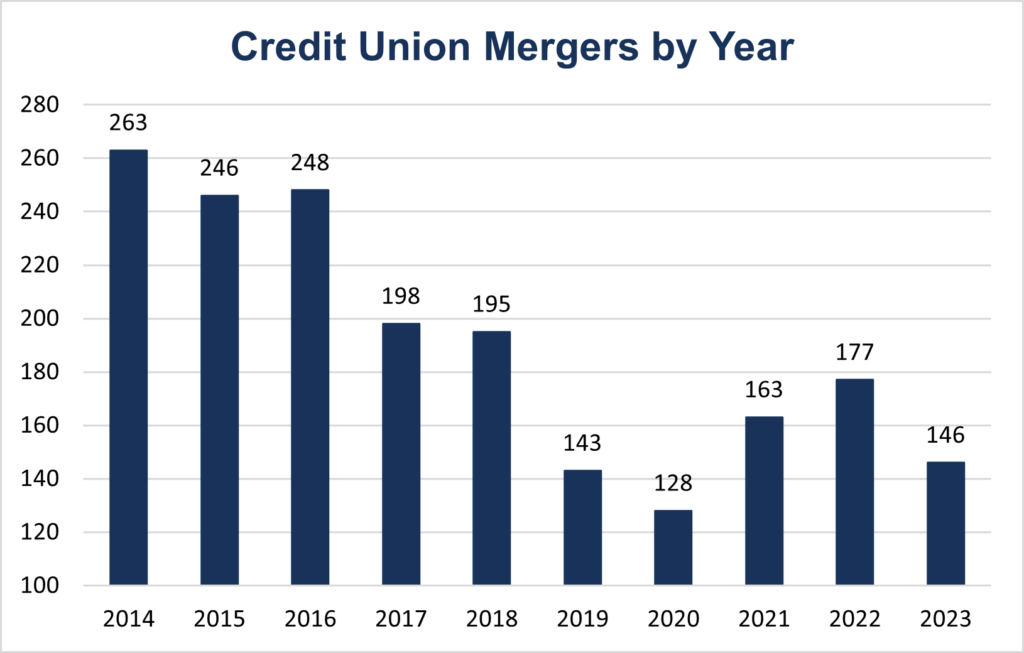
While the number of total mergers has decreased over the past five years, the average asset size of the credit unions being merged-in has remained generally higher since 2019, including a peak average credit union asset size of $63.7 million in 2023.
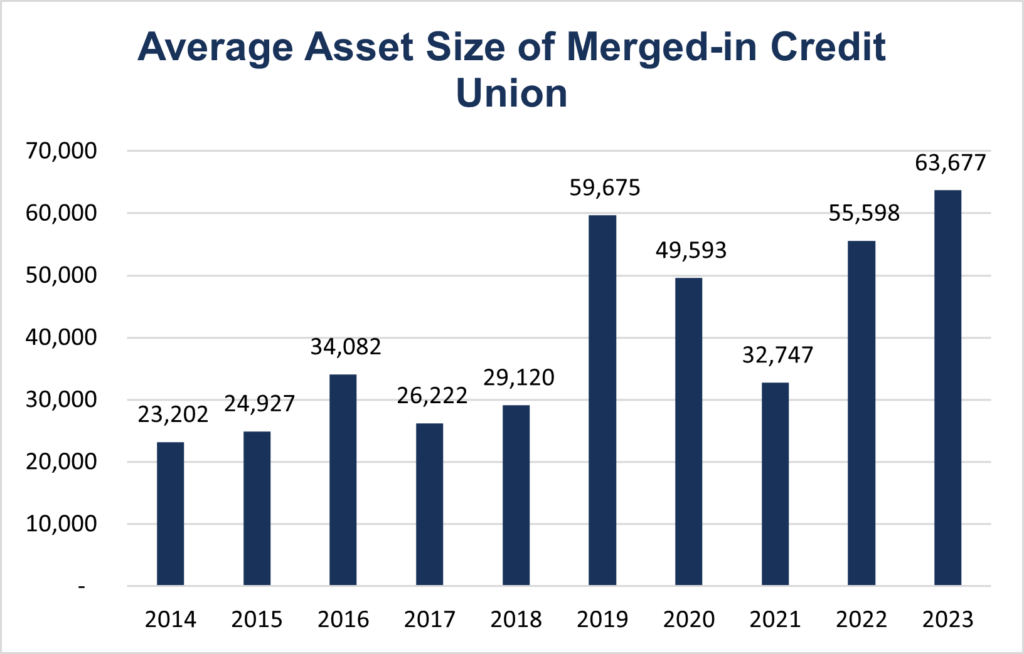
In particular, we note that the number of “mergers of equals” over the past five years has contributed to this increase. There have been eight mergers where the merging-in credit union has exceeded $1 billion in total assets since 2019, as compared to two mergers from 2014 to 2018. These include:
- Gesa Credit Union merger with Inspirus Credit Union in 2019
- SchoolsFirst Federal Credit Union merger with Schools Financial Credit Union in 2019
- TruStone Financial Federal Credit Union merger with Firefly Federal Credit Union 2020
- State Employees Federal Credit Union merger with Capital Communications Federal Credit Union in 2022
- New England Federal Credit Union merger with Vermont State Employees Credit Union in 2022
- Merrimack Valley Credit Union merger with RTN Federal Credit Union in 2023
- TwinStar Credit Union merger with Northwest Community Credit Union in 2023
- Spire Credit Union merger with Hiway Credit Union in 2023
Despite the recent increase in total assets acquired, most mergers since 2019 consisted of a much larger credit union acquiring an institution equal to less than 10% of the acquirer’s total assets. Conversely, only 7% of mergers were classified as a “merger of equals” over this same time period.
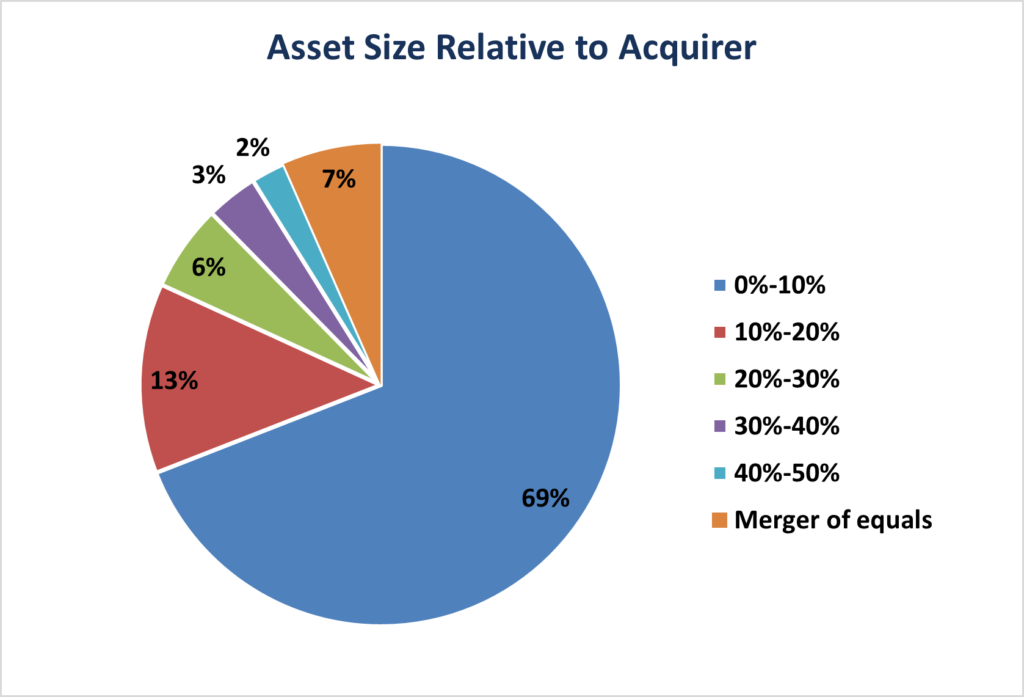
While the number of credit union mergers has decreased since peaking in the 2010’s, credit union acquisition of banks has increased and remained elevated since 2018. Although the number of actual transactions historically is quite small relative to the number of mergers and acquisitions that take place each year, this trend has become a hot topic in the industry. We note that the 14 announced deals in 2022 were an all-time record. Moreover, the 11 announced deals in 2023 are equal to 11.2% of the announced total transactions – a record high for the credit union industry. We expect this trend to continue, as there have already been 12 announced deals through June of 2024. Further detail surrounding the strategic, tax, and regulatory considerations concerning these types of transaction can be found in our white paper titled Credit Unions Purchasing Community Banks.
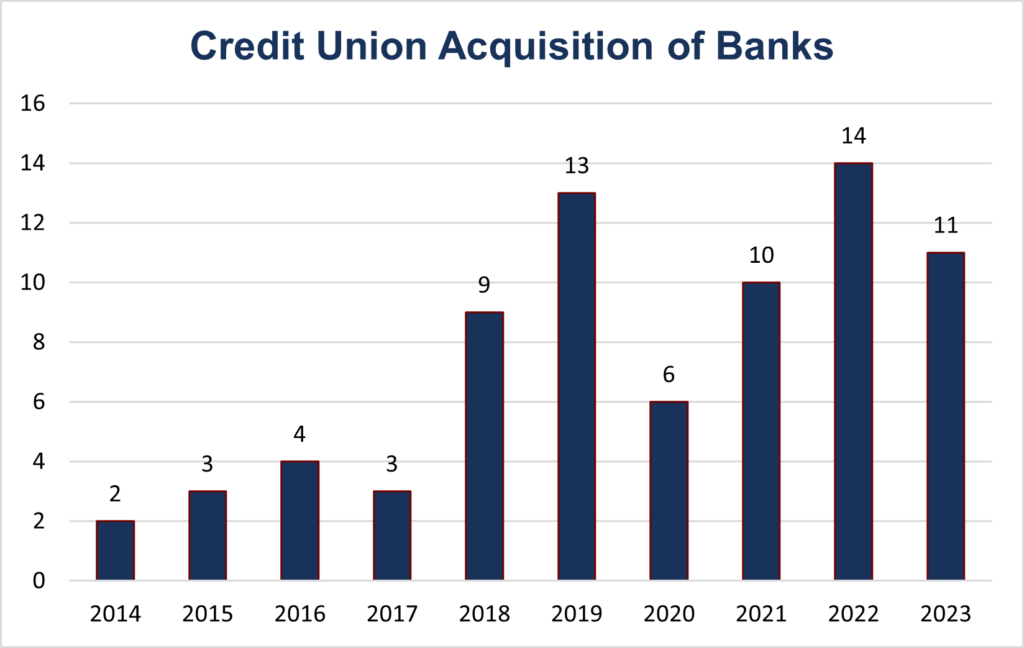
Wilary Winn Merger Financial Statistics
Wilary Winn serves nearly 300 credit unions, including 41 of the top 100. We have performed over 600 merger engagements since 2009, ranging in transaction size from $2M to as large as $3B in total assets. We note that all valuation work is performed on the acquired institution.
Purchase accounting requires that the merged-in institution’s balance sheet be recorded at fair value. To estimate the value of the acquired credit union, we begin by estimating the fair value of the equity acquired. We then estimate the fair value of the financial and non-financial assets and liabilities. Our third step is to estimate the value of the core deposit intangible. Next, we estimate the value of the trade name. Our final step is to estimate the amount of goodwill or bargain gain arising from the merger. The following charts reflect data compiled from valuation work we have performed since 2009.
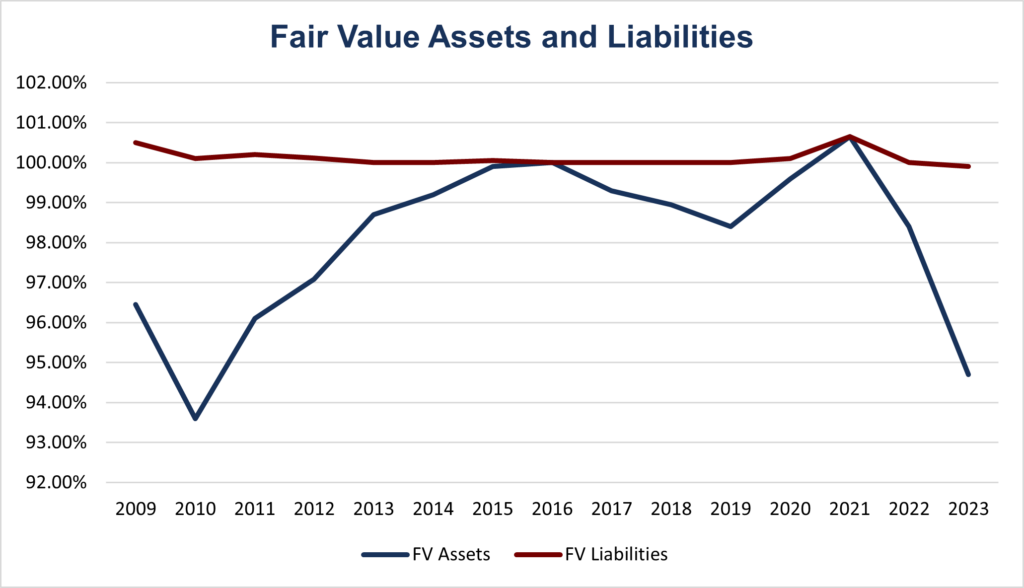
The fair value of assets and liabilities calculated in our valuation work is shown in the chart above. While the fair value of liabilities has remained relatively consistent throughout time, the fair value of assets has moved considerably since 2009. The fair value of loan portfolios is driven by expected credit losses and the portfolio interest rates relative to market. The marked improvement in our clients’ loan portfolios subsequent to 2010 is reflective of better credit quality with enhanced underwriting standards and improving economic conditions coming out of the Great Recession. The fair value of assets acquired further increased in 2020 and 2021, driven by increased premiums resulting from decreases in market interest rates on loans and investments. The low interest rates resulted from rate cuts during the COVID-19 pandemic.
The fair value of assets acquired has significantly decreased over the past 2 years following the Federal Reserve’s first interest rate increase in March 2022. Rising market interest rates have resulted in significant devaluation of acquired assets, particularly investments and loans.
Loans
Wilary Winn’s loan valuations include both a mark-to-market discount rate difference and a lifetime credit loss estimate. The graph below shows the inverse relationship between our lifetime credit loss mark and the overall fair value of the loan portfolio. As loan portfolios recovered from the large losses incurred during the Great Recession, our fair value marks increased. As noted above, premiums on acquired loans peaked in 2021 due to the low interest rate environment during that time. Since then, the fair value of acquired loans has significantly decreased, as the Federal Reserve raised the target range for the federal funds rate over the course of 2022 and 2023 from its near-zero level at the beginning of 2022 to a target range of 5.25% to 5.50% as of the date of this white paper.
Notably, while discounts on acquired loans have significantly widened over the previous 2 years, lifetime credit loss estimates have remained historically low, as compared to losses forecasted and incurred during the financial crisis of 2008 through 2010. We attribute these lower loss estimates to the massive federal stimulus response to COVID-19 as well as to the stricter underwriting standards used beginning in 2011.
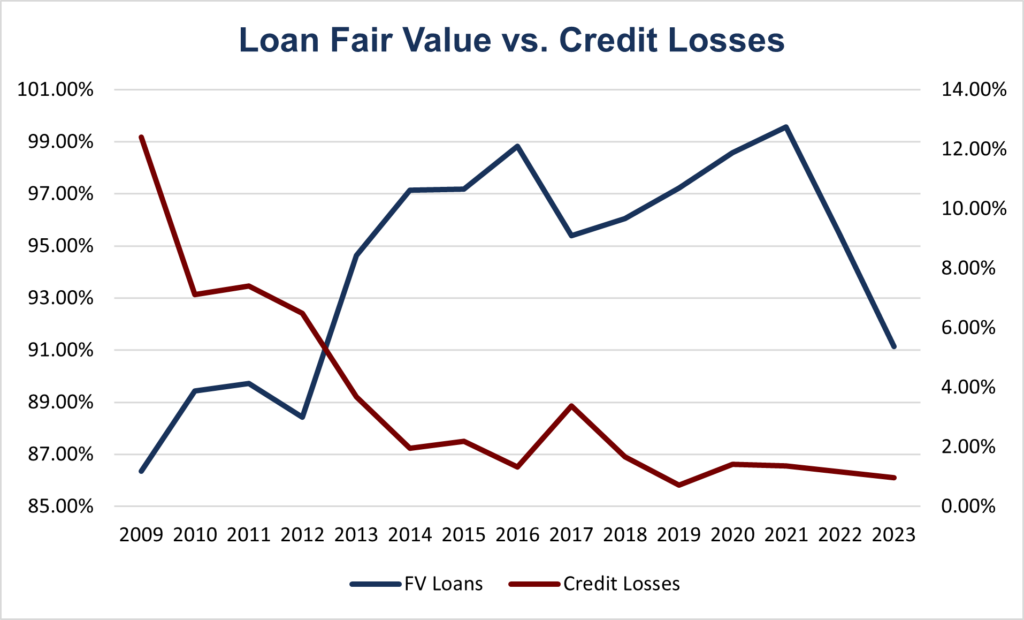
Share Accounts and Core Deposit Intangibles
The premise underlying the core deposit intangible is that a rational buyer is willing to pay a premium to obtain a group of core deposit accounts that are less expensive than the buyer’s marginal cost of funds. Wilary Winn’s calculations of the core deposit intangible from 2009 through year-end 2023 are shown in the following chart. Following near-zero core deposit intangibles in 2020 and 2021, core deposit intangibles reached new highs in 2022 and 2023 due to increases in market borrowing costs (marginal cost of funds), while the rates paid on deposits at most institutions increased at a much slower pace. This increased spread increases the benefits of holding deposits relative to borrowing, thus increasing the intangible benefit.
Wilary Winn notes that the core deposit intangible is typically the most expensive accounting cost related to a merger, as this intangible asset must be amortized over time as a decrease in non-interest income.
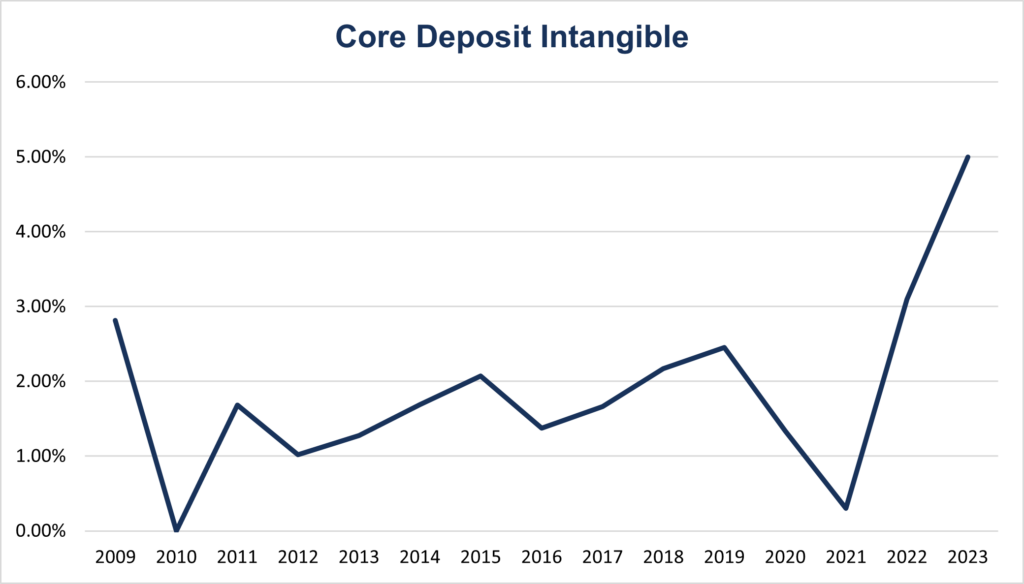
Equity
The chart below shows the fair value of the equity acquired in merger as a percentage of book equity for all merger transactions performed by Wilary Winn since 2009. Wilary Winn employs three basic methods to estimate the overall value of the entity: discounted cash flow, guideline transaction, and guideline public company. The discounted cash flow method is considered an income approach, whereas the guideline transaction and guideline public company methods are considered market approaches. Similar to the fair value of assets, the fair value of the equity acquired has increased significantly over the period shown and is currently above par. Wilary Winn notes that premiums paid for credit unions tend to be lower than bank premiums seen in the marketplace. We attribute this to bank shareholders’ direct access to earnings in the form of share prices and direct dividends, whereas credit unions typically pay out earnings to members in the form of increased services, lower loan rates, and higher deposit rates over time.
We attribute the decreased fair value of equity acquired in 2023 to suppressed price-to-tangible book values paid for banks using our guideline transaction approach coupled with compressed price-to-tangible book values on publicly traded bank stocks using our guideline public company approach.
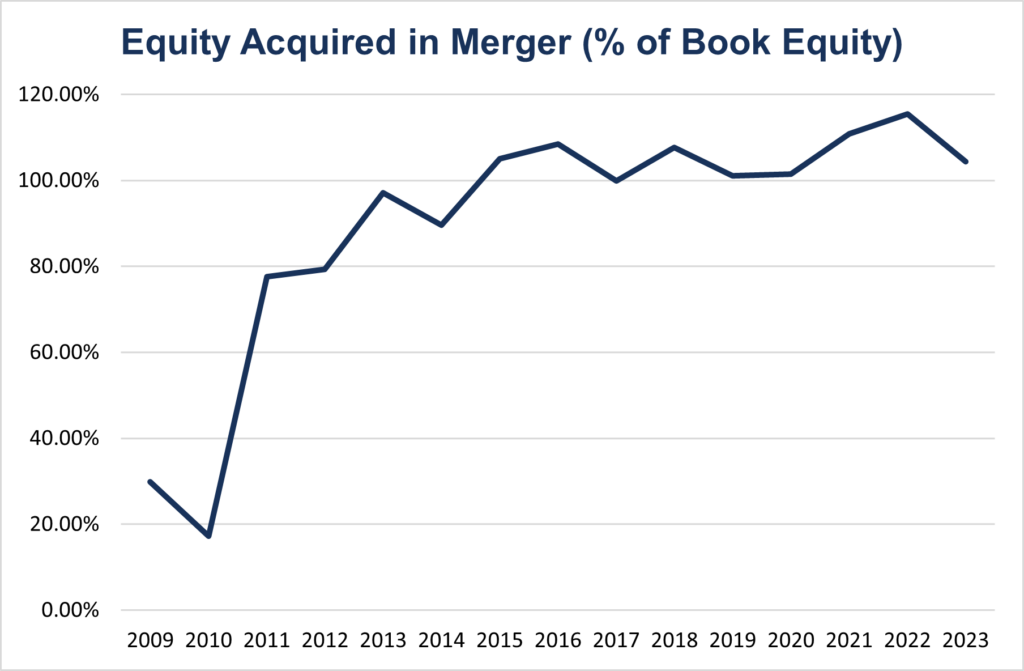
Goodwill and Bargain Purchases
Under the purchase accounting rules, the value of goodwill is the “plug” or the difference between the fair value of equity and the fair values of the net assets recorded on the acquisition date. The accounting rules presume that goodwill will be recorded on “day one.” The rules contemplate the recording of a bargain purchase when the fair value of the net assets exceeds the fair value of equity recorded. However, bargain purchases are intended to be relatively rare events. In fact, the rules require that an acquirer “double check” its work before recording a bargain purchase.
Only 6% of our valuations resulted in a bargain purchase gain, which we generally see only when the institution being merged-in is distressed or in NCUA-assisted transactions.
Merger Industry – Looking Forward
While future merger activity remains uncertain, we continue to see a relatively strong level of mergers year-over-year. We believe the following trends will drive the credit union merger marketplace over the next few years.
- We expect the current relatively high interest rate environment to persist over the next year, creating challenges in maintaining core deposits. As a result, we anticipate smaller institutions will continue to struggle to grow and will ultimately seek merger partners due to the higher percentage of regulatory costs to total costs incurred in operating a small financial institution.
- Asset quality began to normalize over the last year following the historically strong governmental assistance provided to borrowers over the most recent few years in response to the pandemic and recovery. However, the increased earnings volatility associated with the CECL standard coupled with now rising levels of delinquencies and net charge-offs will weigh on credit union earnings. While capital levels remain relatively strong across the industry, we believe many smaller institutions will seek to be merged-in before their capital erodes to unacceptable levels.
- The pandemic accelerated the shift of many institutions’ members to digital banking and highlighted the need for strong technological solutions. However, credit unions often lack the resources to adequately meet the technology requirements of their members. As a result, many institutions will seek merger partners with superior technology or combine to have the resources required to offer the electronic banking demanded in the marketplace.
- We expect to continue to see an increase in the number of mergers of equals. Credit unions of moderate size view the opportunity to merge as a means to quickly achieve economies of scale to better compete in the ever-evolving financial services industry.
- We expect credit union purchases of banks to increase in 2024, as credit unions will continue looking for strategic ways to scale and grow membership bases.